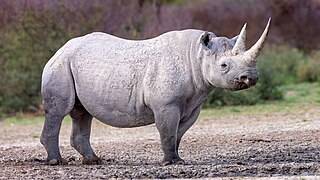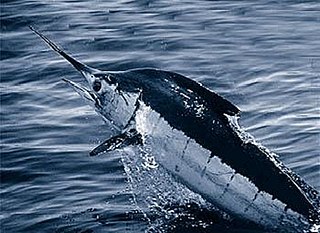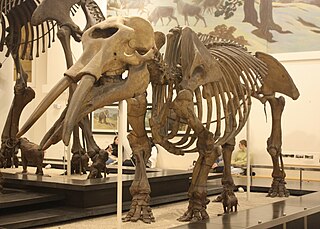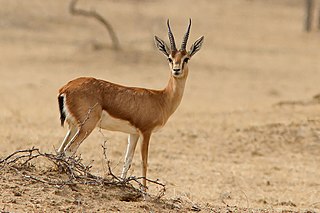
The Miocene is the first geological epoch of the Neogene Period and extends from about 23.03 to 5.333 million years ago (Ma). The Miocene was named by Scottish geologist Charles Lyell; the name comes from the Greek words μείων and καινός and means "less recent" because it has 18% fewer modern marine invertebrates than the Pliocene has. The Miocene followed the Oligocene and preceded the Pliocene.

The black rhinoceros, sometimes also called the hook-lipped rhinoceros, is a species of rhinoceros, native to eastern Africa and southern Africa, including Angola, Botswana, Kenya, Malawi, Mozambique, Namibia, South Africa, Eswatini, Tanzania, Zambia, and Zimbabwe. Although the species is referred to as black, its colours vary from brown to grey. It is the only extant species of the genus Diceros.

A rhinoceros, commonly abbreviated to rhino, is a member of any of the five extant species of odd-toed ungulates in the family Rhinocerotidae; it can also refer to a member of any of the extinct species of the superfamily Rhinocerotoidea. Two of the extant species are native to Africa, and three to South and Southeast Asia.

Diceros is a genus of rhinoceros containing the extant black rhinoceros (Diceros bicornis) and several extinct species.

Ceratotherium is a genus of the family Rhinocerotidae, consisting of a single extant species, the white rhinoceros, as well as several fossil species.

Anser is a waterfowl genus that includes the grey geese and the white geese. It belongs to the true goose and swan subfamily of Anserinae under the family of Anatidae. The genus has a Holarctic distribution, with at least one species breeding in any open, wet habitats in the subarctic and cool temperate regions of the Northern Hemisphere in summer. Some also breed farther south, reaching into warm temperate regions. They mostly migrate south in winter, typically to regions in the temperate zone between the January 0 °C (32 °F) and 5 °C (41 °F) isotherms.

Ancylotherium is an extinct genus of the family Chalicotheriidae, subfamily Schizotheriinae, endemic to Europe, Asia, and Africa during the Late Miocene-Early Pleistocene, existing for approximately 9.8 million years.

Makaira is a genus of marlin in the family Istiophoridae. It includes the Atlantic blue and Indo-Pacific blue marlins. In the past, the black marlin was also included in this genus, but today it is placed in its own genus, Istiompax.

Gomphotherium is an extinct genus of gomphothere proboscidean from the Neogene of Eurasia, Africa and North America. It is the most diverse genus of gompothere, with over a dozen valid species. The genus is probably paraphyletic.

The eastern black rhinoceros, also known as the East African black rhinoceros, is a subspecies of the black rhinoceros. Its numbers are very low due to poaching for its horn, and it is listed as critically endangered.

The western black rhinoceros or West African black rhinoceros is an extinct subspecies of the black rhinoceros. It was declared extinct by the IUCN in 2011. The western black rhinoceros was believed to have been genetically different from other rhino subspecies. It was once widespread in the savanna of sub-Saharan Africa, but its numbers declined due to poaching. The western black rhinoceros resided primarily in Cameroon, but surveys since 2006 have failed to locate any individuals.

Nakalipithecus nakayamai, sometimes referred to as the Nakali ape, is an extinct species of great ape from Nakali, Kenya, from about 9.9–9.8 million years ago during the Late Miocene. It is known from a right jawbone with 3 molars and from 11 isolated teeth. The jawbone specimen is presumed female as the teeth are similar in size to those of female gorillas and orangutans. Compared to other great apes, the canines are short, the enamel is thin, and the molars are flatter. Nakalipithecus seems to have inhabited a sclerophyllous woodland environment.

Chilotherium is an extinct genus of rhinocerotids endemic to Eurasia during the Miocene through Pliocene living for 13.7—3.4 mya, existing for approximately 10.3 million years.
Paratetralophodon is an extinct genus of proboscidean from late Neogene deposits in India and China. Although traditionally classified in the family Gomphotheriidae, recent studies find it to be more closely related to modern elephants.

Zygolophodon is an extinct genus of mammutid proboscidean that lived during the Miocene in Africa, Eurasia, and North America.

A gazelle is one of many antelope species in the genus Gazella. There are also seven species included in two further genera; Eudorcas and Nanger, which were formerly considered subgenera of Gazella. A third former subgenus, Procapra, includes three living species of Asian gazelles.

Ceratotherium neumayri is a fossil species of rhinoceros from the Late Miocene (Vallesian-Turolian) of the Balkans and Western Asia, with remains known from Greece, Bulgaria, Iran, and Anatolia in Turkey.

Hippotherium is an extinct genus of horse that lived in during the Miocene through Pliocene ~13.65—6.7 Mya, existing for 6.95 million years.

Konobelodon is an extinct genus of amebelodont proboscidean from the Miocene of Africa, Eurasia and North America.
Paradiceros is an extinct genus of rhinocerotid that lived in east Africa during the Late Miocene, between 13.7 and 9 million years ago.

















